The Earliest Army
The earliest Roman army is usually described as composed of about 1,000 men per tribe drawn in 100 man levies. The soldiers were armed as Greek Hoplites and fought in a simple Phalanx. The drawing below shows the phalanx with 125 files and 8 ranks with 0.46m (18") for the files and 1.2m (4') for the ranks.

In the above drawing and in all of the following drawings of legion formations the boxes around the formations are all drawn at the same scale so that the relative sizes of the various configurations can be directly compared. The box measures 1,400 ft. by 920 ft. In this case the army occupies only a small part of the field. Later legions will be seen to almost fill the space.
The 4,000 MAN Five Class Army
Tradition attributes the reorganization of the army to the sixth king, Servius Tullius, although the actual process may have taken a number of years. By the time of the war with Veii the army probably had fully developed the 5 classes. Without detailed descriptions of the army formed from the classes one can only make reasonable guesses about its composition. In this model the same number of men are assumed to have been levied from each Century, the phalanx is kept at the Greek standard of 8 ranks, and the overall army size is about 4,000.
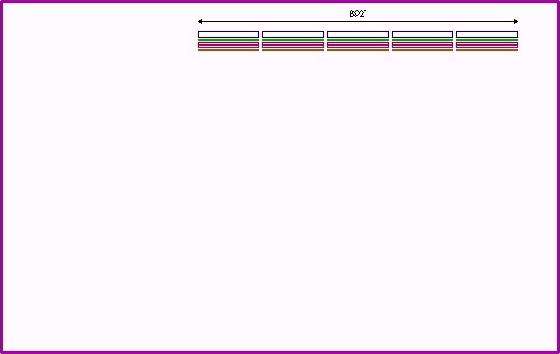
If 25 men from each Century were levied then there would have been 2,000 from the First Class, 500 from Classes II through IIII and 750 from Class V. 4,000 men in 8 Ranks will fill 500 Files. That would give the First Class 4 Ranks, Classes II through IIII one Rank each and leave 750 men in Class V for the 500 files of the last Rank.
The last Rank is represented as composed of 500 men of the Fifth Class with the remaining 250 men being used as skirmishers, flankers or camp guards. In the drawing this presumed 250 man unit is not depicted. Although barely visible at this scale, the Phalanx in the drawing above is divided into separate ranks by Class. Each Class is given a different color.
Under the assumption that the Phalanx would have been somehow subdivided into smaller units, the 500 files have been divided into units of 100 files 8 ranks deep and separated by three meters (ten feet) to provide room for the phalanx to maneuver. Of course, the actual armies were never so nicely composed, but this configuration at least gives a reasonable starting point for visualizing the army.
The Early Livy Legion
The earliest legion is generally said to be the 45 unit legion as described by Livy and dates to the early part of the 4th century BC. The model shown here is based on the description given by Peter Connolly, however other authors offer similar descriptions.

The maniple consisted of two centuries of 10 files by 3 ranks. All maniples had the same number of men. In front of each Hastati maniple there were 20 skirmishers called Leves. All maniples were armed with the spear and oval shield. Connolly gives no spacing for the individuals so I have used the spacing most frequently mentioned: 0.91m ( 3') for each file and 1.2m (4') for each rank.
In the illustration above the triangle represents a legionary soldier, the square represents a centurion. In later drawings the Optio is represented by a circle. Other figures such as standard bearers are not depicted in these drawings. Spacings are accurate and the triangles occupy about the same space an individual would. Fully detailed drawings of some of these formations are shown in later pages.
In addition to the Hastati, Principes and Triarii, Connolly includes equal size units of the Rorarii and Accensi, both armed with shields and spears, and placed behind the Triarii.

Connolly does not give specific spacing for the lines; 73m (240') or 76m (250') are the distances between lines most frequently cited by others. The drawing above uses 76m between the lines.
An Alternative Early Legion
Delbrück offers an alternate interpretation of the Livy legion, different from Connolly in his analysis of the Rorarii and Accensi. He works from Livy's number: 186 men "antipilani" and "sub signis." His explanation is that the Triarii were at one time called the Pilani and that the Triarii, Rorarii and Accensi were positioned behind the standards. Those behind the standards, then, were the 60 men of the Triarii; plus the 120 Rorarii attached in units of 40 men to each of the Hastati, Principes and Triarii maniples; plus the 6 Accensi, orderlies or company clerks; for a total of 186 men.

He considers the Leves, the skirmishers, to be a part of the 40 man Rorarii unit assigned to each Hastati maniple. For the 10 Hastati maniples that would place some 200 skirmishers directly in front of the battle line. These are the men who would retreat through the gaps in the Hastati line. He also mentions that there may have been other skirmishers on the flanks; possibly the other 20 Rorarii of the Hastati maniples. He does not believe the Rorarii of the Principes and Triarii maniples were combat soldiers at all, but rather were unarmed assistants. The Accensi, he says, were totally misinterpreted by Livy. These were the 6 orderlies of the cohort. In muster formation the three 40 man Rorarii units would stand behind the 60 man Triarii maniples. Behind them would stand the 6 Accensi orderlies. This gives the number of 186 men as "sub Signis."
Delbrück argues against the notion that the legion actually went into battle with wide gaps between the maniples. His view is that the legion was really an articulated Phalanx with only small intervals between the maniples to allow adjustments in spacing due to irregular terrain and errors in marching. The gaps would be naturally closed by the men in the adjoining maniples at the time contact is made. If larger gaps opened whole units such as centuries or maniples of the Principes would fill in. The maniples of the Principes would have lined up on the small intervals in the Hastati.

The Delbrück maniple has men on 0.91m (3') spacing both for file and rank with the centuries placed side by side. Each century has 10 files and 6 ranks. The placement of the centurions is not given. Delbrück recognizes the requirement for 1.83m (6') of fighting room for each individual given by Vegetius. However he interprets the 1.83m (6') spacing as being between adjacent ranks, not files. His method is to have alternate ranks step to the side to fill in the gaps in the rank in front. In this way there is 1.83m (6') between rank 1 and rank 3 The Delbrück maniple in battle formation had a staggered formation.
Twenty men from each Rorarii unit attached to the Hastati are depicted as skirmishers spread in a thin line in front of the legion. They would retreat through the narrow gaps between the maniples. The other twenty men of the Hastati Rorarii units may have been used as skirmishers on the flanks; they are not depicted in the schematic. The balance of the Rorarii and Accensii are placed at the bottom of the schematic to indicate that they were, in Delbrück's reconstruction, not a part of the battle and may have been left as camp guards.
The Triarii maniples are comprised of two 30 man centuries aligned one behind to other to maintain a 6 Rank depth. Delbrück states that a depth of fewer than 6 Ranks would not have been an effective force and that the maniples could make up for the gap because of the distance they had between themselves and the battle lines would allow them time and space to maneuver to close the gaps if necessary.
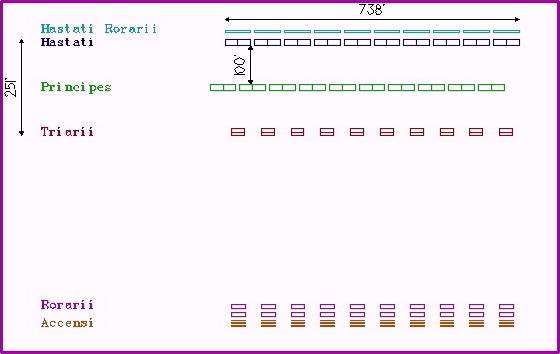
Delbrück does not specify how wide the small gaps between maniples were, but he does allow enough for the 20 skirmishers to retreat. The model uses a spacing between maniples of 3.05m (10') which seems large enough to allow the 20 skirmishers room to retreat and small enough for a few men on either side to close the gap.
Delbrück also argues that the 76m (250') spacing of the later legions is an echelon tactic introduced first by Hannibal and adopted into the Roman system by Scipio Africanus, sometime between 211 and 200 BC, probably in Spain. Prior to his innovation the three lines, Delbrück believes, would have been fairly close together, about 30m (100'). The legion formation shown here incorporates these elements.
The 4,200-man Republican Legion

At some time after 340 BC the legion was reorganized again. It may have been about this time that 200 of the Rorarii were withdrawn, trained, armed as light skirmishers and named Velites. From this time the legion was configured with the standard 30 maniple formation. The maniple was comprised of two 60 man centuries, usually described as either 10 files by 6 Ranks or 12 files by 5 Ranks. The latter formation is used in this schematic, following Rüstow and others.
In this version of the legion the large Velites units are shown aligned between the two centuries of the Triarii in the third line as they would have been during muster and, perhaps, during battle after they had retired. The centuries of the Hastati and Principes are shown aligned one behind the other. This is the classic formation as it is usually given, by Montross and Rüstow, for example.
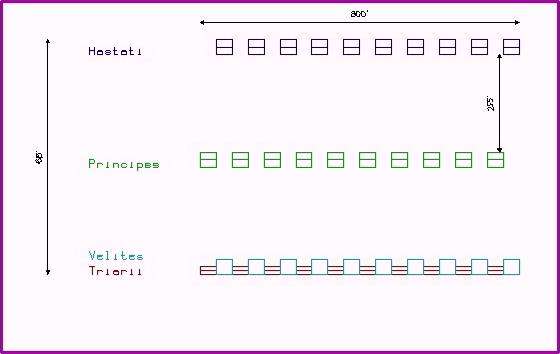 Echelon Tactics
Echelon Tactics
Delbrück credits the development of echelon tactics to Scipio Africanus, probably during his campaigns in Spain. The great advantage of echelon tactics is that it allowed the lines to operate somewhat independently. He also places the introduction of the Pilum to coincide with the new tactics. The legion of Scipio is essentially the same as the earlier legion in its overall formation with the exception that the lines are much further apart, about 76m (250'). In this schematic the Velites are shown in the skirmish position.
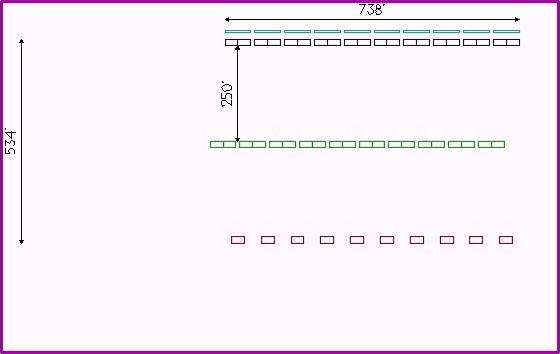 The 4,800-man Legion of Marius -- Cohort Tactics
The 4,800-man Legion of Marius -- Cohort Tactics
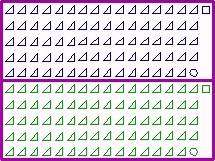
A major change came at the time of Marius and is usually attributed to him, although some elements of the reorganization of the legion may have been implemented prior to Marius' reform. The nominal maniple strength was probably 160 men, divided into two centuries which most authors place one behind the other. The most likely configuration is 16 files by 10 ranks. It has the advantage of scaling down by units of 5 or ten as the maniple strength was depleted.
By the time of Caesar it is clear that the cohort had become the fundamental tactical unit. He describes battle formations and troop movements in terms of cohorts and legions appear more as administrative units than battlefield tactical units. Caesar sends cohorts and groups of cohorts, not legions, on flanking maneuvers.
Since the number of men in a cohort could vary considerably the formation must have been scaleable in some consistent manner so that its fighting efficiency was not destroyed by the reduction in manpower. The typical formation, described above, uses a spacing of 0.91m (3') for the files and 1.22m (4') for the ranks; allowing for the centurion, then, the cohort would have a front of 15.85m (52'). If the three cohorts fought side by side, as is always depicted, then their combined front would have extended to 48.16m (158'). The cohort would, in essence, be a miniature phalanx, 10 ranks deep and 58 files wide.
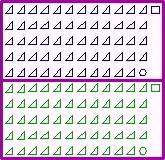
Caesar's legions are usually described as having a strength of about 3,600 men, fewer than the full strength legion. How would the understrength legion have been configured? It seems reasonable that the cohort would be scaled down by reducing the number of files, not the number of ranks. Reducing the number of ranks would decrease the depth and hence the power of the formation. Reducing the number of files would reduce the front but retain the full power of the formation. It therefore seems most logical to retain the full 10 ranks as the depth and reduce the number of files as necessary. The drawing on the right shows two reduced centuries of 5 ranks and 12 files each.
At the battle of Ilerda Caesar's forces were caught on a narrow ridge just wide enough for three cohorts in line of battle. Judson states that this ridge can could be identified in his day and was 110 meters (360') wide. The front of a 12 file cohort is 12.2m (40'), giving a three-cohort unit a front of exactly 109.73m (360'). If Judson's information is correct, it would appear to confirm this formation.
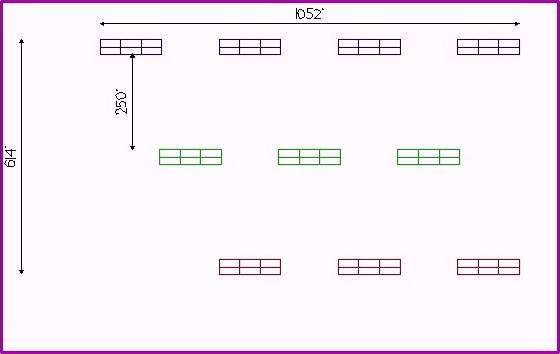
The full strength legion formation in this configuration is shown in the model above.
The Legion of Marius - Alternate Formations
Delbrück does not specifically discuss the question of gaps between the cohorts of the Marian legion. He argues, persuasively I think, against the possibility of gaps in the pre-Marian legion formation in which the units and, consequently, the gaps were much smaller. To be consistent Delbrück would have to be presumed to eliminate the wider gaps in the post-Marian legion, placing the cohorts close together with only small gaps between them. The drawing below shows this legion with 7.62m (25') spaces between the cohorts for the skirmishers. The legion formation in this configuration is much more compact and has a front of only 212m (694').
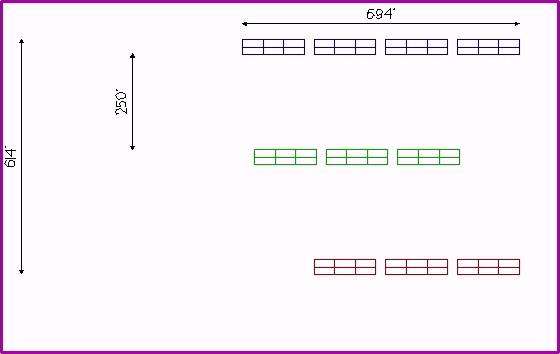
If this were the legion formation then it would be a departure from the earlier legion in that the centuries would now be aligned front to back rather than side by side. In favor of this configuration are: (1) the cohort front fits Judson's information about Ilerda (assuming Judson is accurate), (2) the second century was called the posterior century, and (3) since cohorts were used as quasi-independent tactical units they may have needed the extra depth of the formation.
Against this configuration is the argument for consistency and conservatism. It can be argued that, if the centuries were aligned side by side prior to the reorganization of Marius, then it seems likely that they would have been aligned that way after Marius. The change in the position of the Posterior Century would represent a significant change in tactics, even down to details such as how and when the ranks could employ their pila. The style of fighting had evolved over a long period and may be considered to have been "optimized." That is, the tactics of the individual soldiers armed with the scutum, pilum and gladius which had been evolved to this time were probably those which best suited those weapons; major changes would probably not have been an improvement. Finally, at the level of the century, the soldiers were trained, drilled and led by their centurions who represented a conservative, in the sense "conserving," element in the army; Marius' changes were dramatic enough without also including fundamental changes in tactics at every level and the re-training which would have had to occur.
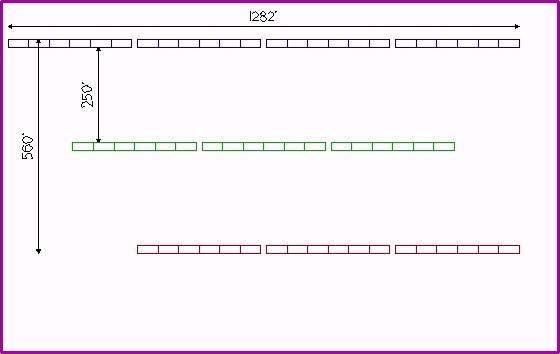
If the centuries were arranged side by side to form an unbroken line, the drawing above shows how this formation may have looked, with 1.53m (5') spaces between maniples and 6.1m (20') spaces between the cohorts. It gives an overall front of 391m (1,282').
The 5,130-man Imperial Legion
During the second half of the first century AD, the size of the cohorts was increased. The regular cohort was increased in size to 480 men in six centuries of 10 files and 8 ranks each. The first cohort was enlarged to 810 men in 5 centuries of 18 files and 9 ranks.

Following the descriptions of Connolly, one century from the new 480 man cohort is depicted on the left and one from the new 810 man first cohort is depicted on the right.
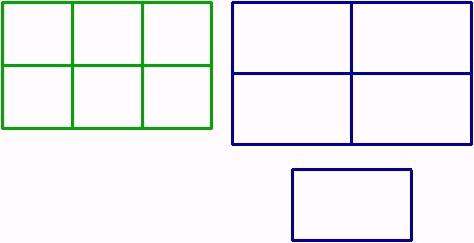
The centuries are usually represented as being arranged two deep with the maniples side by side. For the six centuries of the normal cohort this is a logical formation. For the five centuries of the first cohort the scheme does not work. If four of the centuries are aligned in a rectangle they occupy about the same space as the six centuries of the other cohorts. This would allow them to fit nicely into the overall legion formation. That would leave one extra century.
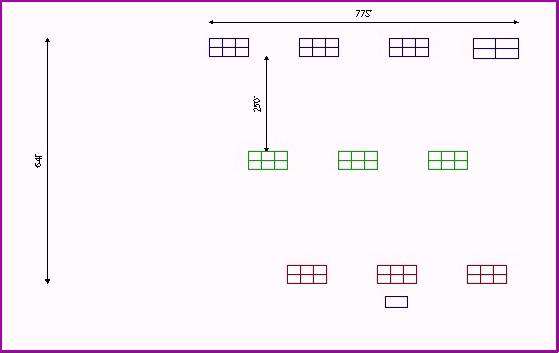
The drawing above shows an imperial legion with the first cohort arranged in a 2 x 2 rectangle. The "extra" century of the first cohort is difficult to fit into the regular legion formation. It could have been attached to the other four centuries of its cohort in some fashion, perhaps to strenghten the right wing. In this model I placed it in the rear as if it were reserved for special duty.
An alternate formation is possible. If the legion did close gaps by aligning the maniples side by side within the cohorts to form a continuous line, then the formation may have looked something like the drawing below. The front of this imperial legion is shorter than for a Caesarian legion shown above because the depth of each century is increased from 5 to 8 Ranks.
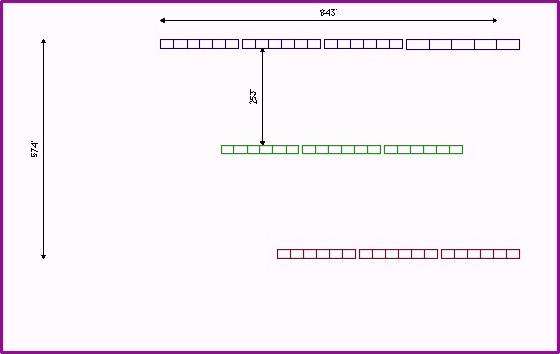 Conclusion
Conclusion
From this brief overview of legion formations according to various authorities it is clear that there are some fundamental questions remaining. The legion was a fighting unit with unique weapons, tactics and formations; and was the most successful army of the ancient world. Yet we do not understand how it functioned in some of the most basic ways.
The legion's formation and tactics were changed over time and were adapted to meet local battlefield conditions. Yet there is a core understanding, an "idealized legion," which can be described. The legion incorporated its own unique characteristics; among them were: the regular use of two and three lines, division of forces into centuries, maniples and cohorts, command by Centurions, use of trumpets and standards, and the tactics of the Pilum and Gladius. The following pages will look at these elements to try to come to a better visualization of how the legion may have actually looked.
 In the above drawing and in all of the following drawings of legion formations the boxes around the formations are all drawn at the same scale so that the relative sizes of the various configurations can be directly compared. The box measures 1,400 ft. by 920 ft. In this case the army occupies only a small part of the field. Later legions will be seen to almost fill the space.
In the above drawing and in all of the following drawings of legion formations the boxes around the formations are all drawn at the same scale so that the relative sizes of the various configurations can be directly compared. The box measures 1,400 ft. by 920 ft. In this case the army occupies only a small part of the field. Later legions will be seen to almost fill the space.
 If 25 men from each Century were levied then there would have been 2,000 from the First Class, 500 from Classes II through IIII and 750 from Class V. 4,000 men in 8 Ranks will fill 500 Files. That would give the First Class 4 Ranks, Classes II through IIII one Rank each and leave 750 men in Class V for the 500 files of the last Rank.
The last Rank is represented as composed of 500 men of the Fifth Class with the remaining 250 men being used as skirmishers, flankers or camp guards. In the drawing this presumed 250 man unit is not depicted. Although barely visible at this scale, the Phalanx in the drawing above is divided into separate ranks by Class. Each Class is given a different color.
Under the assumption that the Phalanx would have been somehow subdivided into smaller units, the 500 files have been divided into units of 100 files 8 ranks deep and separated by three meters (ten feet) to provide room for the phalanx to maneuver. Of course, the actual armies were never so nicely composed, but this configuration at least gives a reasonable starting point for visualizing the army.
If 25 men from each Century were levied then there would have been 2,000 from the First Class, 500 from Classes II through IIII and 750 from Class V. 4,000 men in 8 Ranks will fill 500 Files. That would give the First Class 4 Ranks, Classes II through IIII one Rank each and leave 750 men in Class V for the 500 files of the last Rank.
The last Rank is represented as composed of 500 men of the Fifth Class with the remaining 250 men being used as skirmishers, flankers or camp guards. In the drawing this presumed 250 man unit is not depicted. Although barely visible at this scale, the Phalanx in the drawing above is divided into separate ranks by Class. Each Class is given a different color.
Under the assumption that the Phalanx would have been somehow subdivided into smaller units, the 500 files have been divided into units of 100 files 8 ranks deep and separated by three meters (ten feet) to provide room for the phalanx to maneuver. Of course, the actual armies were never so nicely composed, but this configuration at least gives a reasonable starting point for visualizing the army.
 The maniple consisted of two centuries of 10 files by 3 ranks. All maniples had the same number of men. In front of each Hastati maniple there were 20 skirmishers called Leves. All maniples were armed with the spear and oval shield. Connolly gives no spacing for the individuals so I have used the spacing most frequently mentioned: 0.91m ( 3') for each file and 1.2m (4') for each rank.
In the illustration above the triangle represents a legionary soldier, the square represents a centurion. In later drawings the Optio is represented by a circle. Other figures such as standard bearers are not depicted in these drawings. Spacings are accurate and the triangles occupy about the same space an individual would. Fully detailed drawings of some of these formations are shown in later pages.
In addition to the Hastati, Principes and Triarii, Connolly includes equal size units of the Rorarii and Accensi, both armed with shields and spears, and placed behind the Triarii.
The maniple consisted of two centuries of 10 files by 3 ranks. All maniples had the same number of men. In front of each Hastati maniple there were 20 skirmishers called Leves. All maniples were armed with the spear and oval shield. Connolly gives no spacing for the individuals so I have used the spacing most frequently mentioned: 0.91m ( 3') for each file and 1.2m (4') for each rank.
In the illustration above the triangle represents a legionary soldier, the square represents a centurion. In later drawings the Optio is represented by a circle. Other figures such as standard bearers are not depicted in these drawings. Spacings are accurate and the triangles occupy about the same space an individual would. Fully detailed drawings of some of these formations are shown in later pages.
In addition to the Hastati, Principes and Triarii, Connolly includes equal size units of the Rorarii and Accensi, both armed with shields and spears, and placed behind the Triarii.
 Connolly does not give specific spacing for the lines; 73m (240') or 76m (250') are the distances between lines most frequently cited by others. The drawing above uses 76m between the lines.
Connolly does not give specific spacing for the lines; 73m (240') or 76m (250') are the distances between lines most frequently cited by others. The drawing above uses 76m between the lines.
 He considers the Leves, the skirmishers, to be a part of the 40 man Rorarii unit assigned to each Hastati maniple. For the 10 Hastati maniples that would place some 200 skirmishers directly in front of the battle line. These are the men who would retreat through the gaps in the Hastati line. He also mentions that there may have been other skirmishers on the flanks; possibly the other 20 Rorarii of the Hastati maniples. He does not believe the Rorarii of the Principes and Triarii maniples were combat soldiers at all, but rather were unarmed assistants. The Accensi, he says, were totally misinterpreted by Livy. These were the 6 orderlies of the cohort. In muster formation the three 40 man Rorarii units would stand behind the 60 man Triarii maniples. Behind them would stand the 6 Accensi orderlies. This gives the number of 186 men as "sub Signis."
Delbrück argues against the notion that the legion actually went into battle with wide gaps between the maniples. His view is that the legion was really an articulated Phalanx with only small intervals between the maniples to allow adjustments in spacing due to irregular terrain and errors in marching. The gaps would be naturally closed by the men in the adjoining maniples at the time contact is made. If larger gaps opened whole units such as centuries or maniples of the Principes would fill in. The maniples of the Principes would have lined up on the small intervals in the Hastati.
He considers the Leves, the skirmishers, to be a part of the 40 man Rorarii unit assigned to each Hastati maniple. For the 10 Hastati maniples that would place some 200 skirmishers directly in front of the battle line. These are the men who would retreat through the gaps in the Hastati line. He also mentions that there may have been other skirmishers on the flanks; possibly the other 20 Rorarii of the Hastati maniples. He does not believe the Rorarii of the Principes and Triarii maniples were combat soldiers at all, but rather were unarmed assistants. The Accensi, he says, were totally misinterpreted by Livy. These were the 6 orderlies of the cohort. In muster formation the three 40 man Rorarii units would stand behind the 60 man Triarii maniples. Behind them would stand the 6 Accensi orderlies. This gives the number of 186 men as "sub Signis."
Delbrück argues against the notion that the legion actually went into battle with wide gaps between the maniples. His view is that the legion was really an articulated Phalanx with only small intervals between the maniples to allow adjustments in spacing due to irregular terrain and errors in marching. The gaps would be naturally closed by the men in the adjoining maniples at the time contact is made. If larger gaps opened whole units such as centuries or maniples of the Principes would fill in. The maniples of the Principes would have lined up on the small intervals in the Hastati.
 The Delbrück maniple has men on 0.91m (3') spacing both for file and rank with the centuries placed side by side. Each century has 10 files and 6 ranks. The placement of the centurions is not given. Delbrück recognizes the requirement for 1.83m (6') of fighting room for each individual given by Vegetius. However he interprets the 1.83m (6') spacing as being between adjacent ranks, not files. His method is to have alternate ranks step to the side to fill in the gaps in the rank in front. In this way there is 1.83m (6') between rank 1 and rank 3 The Delbrück maniple in battle formation had a staggered formation.
Twenty men from each Rorarii unit attached to the Hastati are depicted as skirmishers spread in a thin line in front of the legion. They would retreat through the narrow gaps between the maniples. The other twenty men of the Hastati Rorarii units may have been used as skirmishers on the flanks; they are not depicted in the schematic. The balance of the Rorarii and Accensii are placed at the bottom of the schematic to indicate that they were, in Delbrück's reconstruction, not a part of the battle and may have been left as camp guards.
The Triarii maniples are comprised of two 30 man centuries aligned one behind to other to maintain a 6 Rank depth. Delbrück states that a depth of fewer than 6 Ranks would not have been an effective force and that the maniples could make up for the gap because of the distance they had between themselves and the battle lines would allow them time and space to maneuver to close the gaps if necessary.
The Delbrück maniple has men on 0.91m (3') spacing both for file and rank with the centuries placed side by side. Each century has 10 files and 6 ranks. The placement of the centurions is not given. Delbrück recognizes the requirement for 1.83m (6') of fighting room for each individual given by Vegetius. However he interprets the 1.83m (6') spacing as being between adjacent ranks, not files. His method is to have alternate ranks step to the side to fill in the gaps in the rank in front. In this way there is 1.83m (6') between rank 1 and rank 3 The Delbrück maniple in battle formation had a staggered formation.
Twenty men from each Rorarii unit attached to the Hastati are depicted as skirmishers spread in a thin line in front of the legion. They would retreat through the narrow gaps between the maniples. The other twenty men of the Hastati Rorarii units may have been used as skirmishers on the flanks; they are not depicted in the schematic. The balance of the Rorarii and Accensii are placed at the bottom of the schematic to indicate that they were, in Delbrück's reconstruction, not a part of the battle and may have been left as camp guards.
The Triarii maniples are comprised of two 30 man centuries aligned one behind to other to maintain a 6 Rank depth. Delbrück states that a depth of fewer than 6 Ranks would not have been an effective force and that the maniples could make up for the gap because of the distance they had between themselves and the battle lines would allow them time and space to maneuver to close the gaps if necessary.
 Delbrück does not specify how wide the small gaps between maniples were, but he does allow enough for the 20 skirmishers to retreat. The model uses a spacing between maniples of 3.05m (10') which seems large enough to allow the 20 skirmishers room to retreat and small enough for a few men on either side to close the gap.
Delbrück also argues that the 76m (250') spacing of the later legions is an echelon tactic introduced first by Hannibal and adopted into the Roman system by Scipio Africanus, sometime between 211 and 200 BC, probably in Spain. Prior to his innovation the three lines, Delbrück believes, would have been fairly close together, about 30m (100'). The legion formation shown here incorporates these elements.
Delbrück does not specify how wide the small gaps between maniples were, but he does allow enough for the 20 skirmishers to retreat. The model uses a spacing between maniples of 3.05m (10') which seems large enough to allow the 20 skirmishers room to retreat and small enough for a few men on either side to close the gap.
Delbrück also argues that the 76m (250') spacing of the later legions is an echelon tactic introduced first by Hannibal and adopted into the Roman system by Scipio Africanus, sometime between 211 and 200 BC, probably in Spain. Prior to his innovation the three lines, Delbrück believes, would have been fairly close together, about 30m (100'). The legion formation shown here incorporates these elements.
 At some time after 340 BC the legion was reorganized again. It may have been about this time that 200 of the Rorarii were withdrawn, trained, armed as light skirmishers and named Velites. From this time the legion was configured with the standard 30 maniple formation. The maniple was comprised of two 60 man centuries, usually described as either 10 files by 6 Ranks or 12 files by 5 Ranks. The latter formation is used in this schematic, following Rüstow and others.
In this version of the legion the large Velites units are shown aligned between the two centuries of the Triarii in the third line as they would have been during muster and, perhaps, during battle after they had retired. The centuries of the Hastati and Principes are shown aligned one behind the other. This is the classic formation as it is usually given, by Montross and Rüstow, for example.
At some time after 340 BC the legion was reorganized again. It may have been about this time that 200 of the Rorarii were withdrawn, trained, armed as light skirmishers and named Velites. From this time the legion was configured with the standard 30 maniple formation. The maniple was comprised of two 60 man centuries, usually described as either 10 files by 6 Ranks or 12 files by 5 Ranks. The latter formation is used in this schematic, following Rüstow and others.
In this version of the legion the large Velites units are shown aligned between the two centuries of the Triarii in the third line as they would have been during muster and, perhaps, during battle after they had retired. The centuries of the Hastati and Principes are shown aligned one behind the other. This is the classic formation as it is usually given, by Montross and Rüstow, for example.
 Echelon Tactics
Echelon Tactics The 4,800-man Legion of Marius -- Cohort Tactics
The 4,800-man Legion of Marius -- Cohort Tactics A major change came at the time of Marius and is usually attributed to him, although some elements of the reorganization of the legion may have been implemented prior to Marius' reform. The nominal maniple strength was probably 160 men, divided into two centuries which most authors place one behind the other. The most likely configuration is 16 files by 10 ranks. It has the advantage of scaling down by units of 5 or ten as the maniple strength was depleted.
By the time of Caesar it is clear that the cohort had become the fundamental tactical unit. He describes battle formations and troop movements in terms of cohorts and legions appear more as administrative units than battlefield tactical units. Caesar sends cohorts and groups of cohorts, not legions, on flanking maneuvers.
Since the number of men in a cohort could vary considerably the formation must have been scaleable in some consistent manner so that its fighting efficiency was not destroyed by the reduction in manpower. The typical formation, described above, uses a spacing of 0.91m (3') for the files and 1.22m (4') for the ranks; allowing for the centurion, then, the cohort would have a front of 15.85m (52'). If the three cohorts fought side by side, as is always depicted, then their combined front would have extended to 48.16m (158'). The cohort would, in essence, be a miniature phalanx, 10 ranks deep and 58 files wide.
A major change came at the time of Marius and is usually attributed to him, although some elements of the reorganization of the legion may have been implemented prior to Marius' reform. The nominal maniple strength was probably 160 men, divided into two centuries which most authors place one behind the other. The most likely configuration is 16 files by 10 ranks. It has the advantage of scaling down by units of 5 or ten as the maniple strength was depleted.
By the time of Caesar it is clear that the cohort had become the fundamental tactical unit. He describes battle formations and troop movements in terms of cohorts and legions appear more as administrative units than battlefield tactical units. Caesar sends cohorts and groups of cohorts, not legions, on flanking maneuvers.
Since the number of men in a cohort could vary considerably the formation must have been scaleable in some consistent manner so that its fighting efficiency was not destroyed by the reduction in manpower. The typical formation, described above, uses a spacing of 0.91m (3') for the files and 1.22m (4') for the ranks; allowing for the centurion, then, the cohort would have a front of 15.85m (52'). If the three cohorts fought side by side, as is always depicted, then their combined front would have extended to 48.16m (158'). The cohort would, in essence, be a miniature phalanx, 10 ranks deep and 58 files wide.
 Caesar's legions are usually described as having a strength of about 3,600 men, fewer than the full strength legion. How would the understrength legion have been configured? It seems reasonable that the cohort would be scaled down by reducing the number of files, not the number of ranks. Reducing the number of ranks would decrease the depth and hence the power of the formation. Reducing the number of files would reduce the front but retain the full power of the formation. It therefore seems most logical to retain the full 10 ranks as the depth and reduce the number of files as necessary. The drawing on the right shows two reduced centuries of 5 ranks and 12 files each.
At the battle of Ilerda Caesar's forces were caught on a narrow ridge just wide enough for three cohorts in line of battle. Judson states that this ridge can could be identified in his day and was 110 meters (360') wide. The front of a 12 file cohort is 12.2m (40'), giving a three-cohort unit a front of exactly 109.73m (360'). If Judson's information is correct, it would appear to confirm this formation.
Caesar's legions are usually described as having a strength of about 3,600 men, fewer than the full strength legion. How would the understrength legion have been configured? It seems reasonable that the cohort would be scaled down by reducing the number of files, not the number of ranks. Reducing the number of ranks would decrease the depth and hence the power of the formation. Reducing the number of files would reduce the front but retain the full power of the formation. It therefore seems most logical to retain the full 10 ranks as the depth and reduce the number of files as necessary. The drawing on the right shows two reduced centuries of 5 ranks and 12 files each.
At the battle of Ilerda Caesar's forces were caught on a narrow ridge just wide enough for three cohorts in line of battle. Judson states that this ridge can could be identified in his day and was 110 meters (360') wide. The front of a 12 file cohort is 12.2m (40'), giving a three-cohort unit a front of exactly 109.73m (360'). If Judson's information is correct, it would appear to confirm this formation.
 The full strength legion formation in this configuration is shown in the model above.
The full strength legion formation in this configuration is shown in the model above.
 If this were the legion formation then it would be a departure from the earlier legion in that the centuries would now be aligned front to back rather than side by side. In favor of this configuration are: (1) the cohort front fits Judson's information about Ilerda (assuming Judson is accurate), (2) the second century was called the posterior century, and (3) since cohorts were used as quasi-independent tactical units they may have needed the extra depth of the formation.
Against this configuration is the argument for consistency and conservatism. It can be argued that, if the centuries were aligned side by side prior to the reorganization of Marius, then it seems likely that they would have been aligned that way after Marius. The change in the position of the Posterior Century would represent a significant change in tactics, even down to details such as how and when the ranks could employ their pila. The style of fighting had evolved over a long period and may be considered to have been "optimized." That is, the tactics of the individual soldiers armed with the scutum, pilum and gladius which had been evolved to this time were probably those which best suited those weapons; major changes would probably not have been an improvement. Finally, at the level of the century, the soldiers were trained, drilled and led by their centurions who represented a conservative, in the sense "conserving," element in the army; Marius' changes were dramatic enough without also including fundamental changes in tactics at every level and the re-training which would have had to occur.
If this were the legion formation then it would be a departure from the earlier legion in that the centuries would now be aligned front to back rather than side by side. In favor of this configuration are: (1) the cohort front fits Judson's information about Ilerda (assuming Judson is accurate), (2) the second century was called the posterior century, and (3) since cohorts were used as quasi-independent tactical units they may have needed the extra depth of the formation.
Against this configuration is the argument for consistency and conservatism. It can be argued that, if the centuries were aligned side by side prior to the reorganization of Marius, then it seems likely that they would have been aligned that way after Marius. The change in the position of the Posterior Century would represent a significant change in tactics, even down to details such as how and when the ranks could employ their pila. The style of fighting had evolved over a long period and may be considered to have been "optimized." That is, the tactics of the individual soldiers armed with the scutum, pilum and gladius which had been evolved to this time were probably those which best suited those weapons; major changes would probably not have been an improvement. Finally, at the level of the century, the soldiers were trained, drilled and led by their centurions who represented a conservative, in the sense "conserving," element in the army; Marius' changes were dramatic enough without also including fundamental changes in tactics at every level and the re-training which would have had to occur.
 If the centuries were arranged side by side to form an unbroken line, the drawing above shows how this formation may have looked, with 1.53m (5') spaces between maniples and 6.1m (20') spaces between the cohorts. It gives an overall front of 391m (1,282').
If the centuries were arranged side by side to form an unbroken line, the drawing above shows how this formation may have looked, with 1.53m (5') spaces between maniples and 6.1m (20') spaces between the cohorts. It gives an overall front of 391m (1,282').
 Following the descriptions of Connolly, one century from the new 480 man cohort is depicted on the left and one from the new 810 man first cohort is depicted on the right.
Following the descriptions of Connolly, one century from the new 480 man cohort is depicted on the left and one from the new 810 man first cohort is depicted on the right.
 The centuries are usually represented as being arranged two deep with the maniples side by side. For the six centuries of the normal cohort this is a logical formation. For the five centuries of the first cohort the scheme does not work. If four of the centuries are aligned in a rectangle they occupy about the same space as the six centuries of the other cohorts. This would allow them to fit nicely into the overall legion formation. That would leave one extra century.
The centuries are usually represented as being arranged two deep with the maniples side by side. For the six centuries of the normal cohort this is a logical formation. For the five centuries of the first cohort the scheme does not work. If four of the centuries are aligned in a rectangle they occupy about the same space as the six centuries of the other cohorts. This would allow them to fit nicely into the overall legion formation. That would leave one extra century.
 The drawing above shows an imperial legion with the first cohort arranged in a 2 x 2 rectangle. The "extra" century of the first cohort is difficult to fit into the regular legion formation. It could have been attached to the other four centuries of its cohort in some fashion, perhaps to strenghten the right wing. In this model I placed it in the rear as if it were reserved for special duty.
An alternate formation is possible. If the legion did close gaps by aligning the maniples side by side within the cohorts to form a continuous line, then the formation may have looked something like the drawing below. The front of this imperial legion is shorter than for a Caesarian legion shown above because the depth of each century is increased from 5 to 8 Ranks.
The drawing above shows an imperial legion with the first cohort arranged in a 2 x 2 rectangle. The "extra" century of the first cohort is difficult to fit into the regular legion formation. It could have been attached to the other four centuries of its cohort in some fashion, perhaps to strenghten the right wing. In this model I placed it in the rear as if it were reserved for special duty.
An alternate formation is possible. If the legion did close gaps by aligning the maniples side by side within the cohorts to form a continuous line, then the formation may have looked something like the drawing below. The front of this imperial legion is shorter than for a Caesarian legion shown above because the depth of each century is increased from 5 to 8 Ranks.


